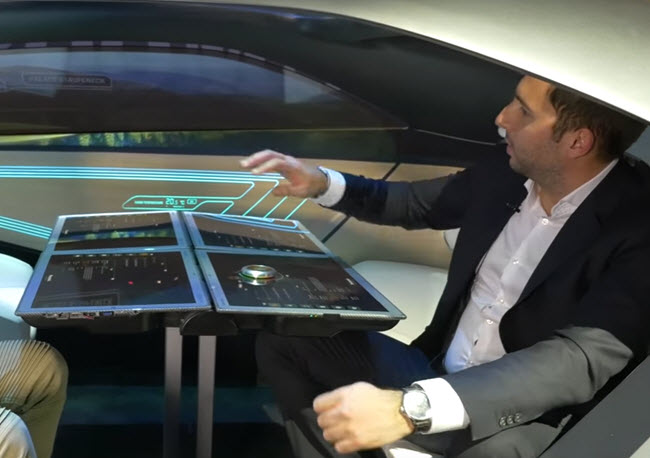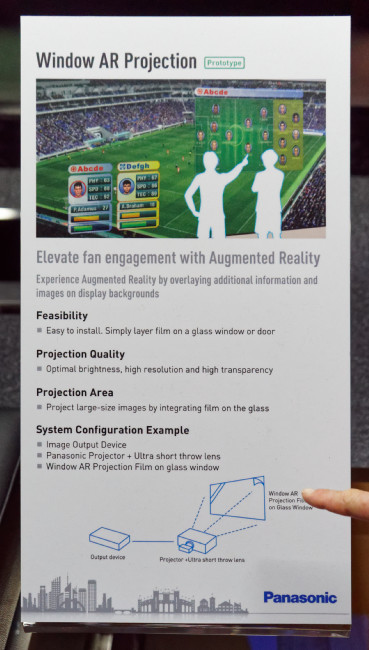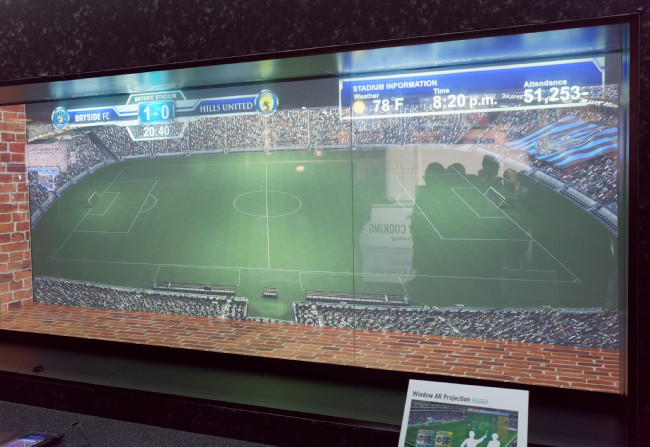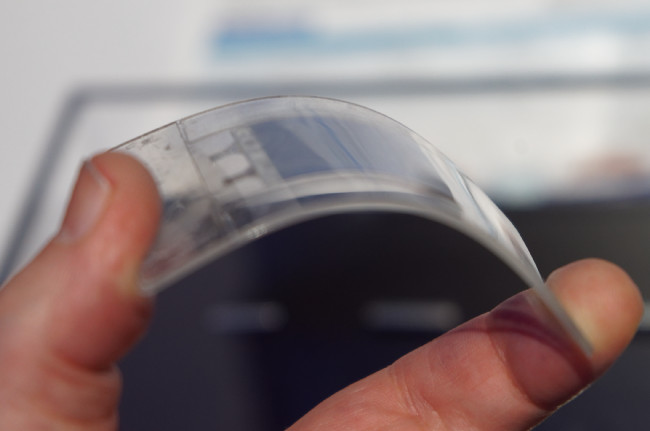Panasonic held its regular press event and, as it has done at the last several that we have attended, it started with discussions about smart cities. The “Smart cities” topic is a big story for Panasonic and last year said the firm that it would work with the city of Denver and the company has developed a ¼ mile (400m) long LED sign coming into airport. The Mayor of Denver came back on stage, one year on, to endorse Panasonic and the collaboration. The city and company have found many opportunities for LED lighting etc.
Panasonic has been doing lots of collaboration and working on big data. Video imaging and projection very big businesses still and the Rio Olympics was a big project for the company. Panasonic will work on the 2020 Olympic event (it’s in Japan, of course). There are now dozens of sports facilities with Panasonic displays, now, since the company decided to get into the sports market in the US. The company is widening its scope to convention and holiday centres and the company will set up a US centre for engineering for this application.
There was a demonstration of the modulated light ‘Li-Fi’ technology, Light ID which it is calling LinkRay, and which we have been reporting on since Gitex in 2015 (there’s a video interview in Panasonic Explains Light ID at Gitex). A representative of Walt Disney came on stage to talk about a long term collaboration between Walt Disney’s Theme Parks and Panasonic to use the technology and the companies are working on a partnership under which Panasonic will supply Disney with projectors and the companies separately announced that Panasonic would be the ‘official projection technology’ for Walt Disney’s theme parks in the US.
Automotive is Big in Panasonic US
Next. the topic switched to automotive and the automotive group is the largest in Panasonic NA. The company is working with Google and Qualcomm to develop new infotainment systems for automotive. There are new apps and the lead time for introducing new products to production will be shorter. Since 2008, the Android products group in Panasonic has introduced 147 Android-based products across a wide range of segments, it was claimed.
 Panasonic showed this car concept on its booth. There are four 4K tablets with a ‘Smart Ring’ controller.
Panasonic showed this car concept on its booth. There are four 4K tablets with a ‘Smart Ring’ controller.
Portal is a new platform for automotive with FCA. Features include driver identification and it can even be used create a drive-through QSR order and pay! IBM was also involved in the development. When drivers are no longer required to operate the car, cabins will change and Panasonic will have a demo on its booth.
The car has to be more connected to the road and to other cars and the company is working on a connected highway of around 70 miles near Denver. There is a big death rate from vehicle accidents – there are 747 per week in the US and 90% of deaths are preventable, Panasonic believes – RoadX is the name of its project. The firm is also keen on extending mobility to those who can’t drive, whether younger or older. The road systems in some areas are full and there is no way to simply increase road sizes, so there is work to be done to make roads more efficient.
Michael Moskowitz came on to talk about consumer products. A new product is a ‘revolutionary cooking appliance’, the Countertop Induction Oven. The Technics brand was re-introduced a couple of years ago and last year a new turntable was introduced. Now there is a new turntable, the 1200GR and new speakers and a new amplifier. Panasonic also has a new mirrorless camera, the GH5, after introducing the GH4 two years ago. Features include indefinite recording (rather than time limited as on some other crossover still/video camera devices) with dual memory slots and hot swapping. The camera supports UltraHD recording at 60fps and DCI 4K at up to 48fps. It can also capture 4:2:2 video at 1080P and supports 400Mbps ‘all-intra’ compression. 4:2:2 10 bit external recording is support at 60fps over HDMI (with a full sized connector). It’s an impressive specification.
Booth
 On its booth, Panasonic had the transparent TV that it showed last year and at IFA and had a strong emphasis on how it could support stadiums and venues. There was a technology demo of a system (called Window AR) using a film layer added onto a glass screen that was acting as a projection screen, overlaying a digital image on the view behind. Panasonic was showing how this could be used to create ‘digital windows’ for sports stadiums.
On its booth, Panasonic had the transparent TV that it showed last year and at IFA and had a strong emphasis on how it could support stadiums and venues. There was a technology demo of a system (called Window AR) using a film layer added onto a glass screen that was acting as a projection screen, overlaying a digital image on the view behind. Panasonic was showing how this could be used to create ‘digital windows’ for sports stadiums.

There was also a demo of a prototype ‘flag mapping’ system. This uses infrared LEDs at the corners of flags which are tracked by an infrared camera which calculates how the flag is distorted, in real time. The system processes an image from a projector to map onto the flag, allowing blank flags to have variable graphics and messages. Panasonic anticipates applications in transport, amusement parks and retail stores as well as public facilities.
The LinkRay LightID system was being demonstrated from an LED backlight. The company said that an ID of up to 128 bits can be sent to a standard smartphone using the camera. The transmission takes up to 0.3 seconds and works for a range of 0.1m to 10m. The SF1H series with integrated LinkRay consists of IPS LCDs with 700 cd/m² of output with contrast of 1,300:1 and available in 42″ (TH-42SF1H), 49″ (TH-49SF1H) and 55″ (TH-55SF1H). They are rated for 24/7 operation and can support simple signage with an integrated USB media player.
The latest version of the Space Player ‘projection light’ was being shown in a number of different demos.
 There was a demonstration of a transparent projection screen for retail applications and which can support the LightID concept to allow data to be passed to viewers. The screen can be switched under system control to be a standard conventional screen as an alternative to the transparent mode. (see image of soccer player). When the demo system was set to transparent, the soccer player disappeared and the window allowed viewing of objects behind.
There was a demonstration of a transparent projection screen for retail applications and which can support the LightID concept to allow data to be passed to viewers. The screen can be switched under system control to be a standard conventional screen as an alternative to the transparent mode. (see image of soccer player). When the demo system was set to transparent, the soccer player disappeared and the window allowed viewing of objects behind.
There were demonstrations of a variety of technologies for automotive and IoT applications. The company was showing a prototype VR headset that has a 220º field of view – much wider than most headsets. There are four different lenses and the company has a video online of the device. https://youtu.be/65HsJcJ5TBo The headset also included bone conduction headphones.
A ‘smart table’ prototype wooden table was on display and that was made of wood but included integrated wireless charging and communication as well as warming or cooling (described as Pelletier, but we think the firm meant based on a ‘Peltier’ effect). The table also has a transparent touch controller and integrated a display.
Panasonic is big in batteries and was showing a flexible Lithium-Ion battery that can be bent 1,000 times while retaining 80% of its capacity. The company also had a demonstration of wireless charging for mobile devices that might use the battery. There are three versions of the battery under development with 17.5/40/60mAh at 3.8V and all with 0.45mm thickness. The smallest is 28.5 x 39mm and the largest is 40 x 65mm and the bending radius is 24mm, and the twisting angle 25º over 100mm.
 Panasonic’s flexible battery can survive a lot of flexing. Image:Meko
Panasonic’s flexible battery can survive a lot of flexing. Image:Meko
Analyst Comment
There was no announcement about OLED TVs at the press event and we later got confirmation that the OLED TV we saw at IFA will not be sold in the US. Chris has covered this (Panasonic Upgrades OLED HDR TV – but Not for North America). There had been rumours circulating that Panasonic had thought about re-entering the US TV market – high end dealers wanted an alternative to Sony/Samsung, as they have lost both Pioneer and Panasonic in recent years. There might be an opportunity for another brand, there, although it’s hard to establish a reputation in that segment. (BR)

